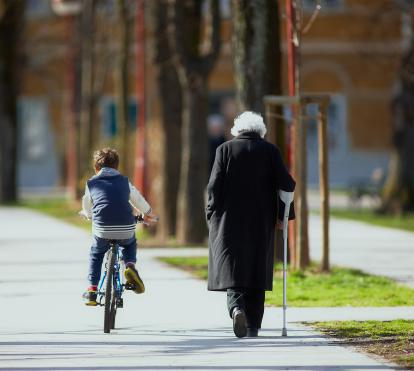
Exhibition: Remains and Traces of Our Ancestors
15.12.04
5 minutes readHow did a swarm of flying insects and arachnids become trapped in the viscous resin of a tree from the Pleistocene? What prompted the indigestion that led one of the most voracious bony fishes, the Xiphactinus audax of the Upper Cretaceous period, to its death? What can we deduce from the skeleton of a Protoceratops dinosaur that lived 75 million years ago and whose crouching fossil was discovered in Mongolia? On 15 December, CosmoCaixa, the science museum of ”la Caixa” Foundation in Alcobendas (Madrid) opens its doors to Remains and Traces of Our Ancestors, an exhibition that looks into the surprising stories of the protagonists of 11 beautifully fossilised groups that have come down to us in a perfect state of conservation.A shark's tooth on which two gorgonians are lodged; the head of a Triceratops that lost its life defending its young from the sudden attack of a Tyrannosaurus; or a school of fish buried by a volcano: these are some of the pieces through which Remains and Traces of Our Ancestors investigates the stories of the protagonists of 11 fossils of enormous value and beauty. Following the clues behind the fossils themselves by means of the scientific method (observation formulation of hypotheses - experimentation data analysis and drawing of conclusions) leads to a sleuthing exercise that enables us to deduce the story behind each of the objects.The secret is revealed, not in written language, but rather through the black and white comic strip. The final vignette, in colour, corresponds to each of the pieces on display. The show will be open to the public at CosmoCaixa Madrid all through 2005. The following are some of the exhibition's featured stories:- Buried Alive. A herd of Protoceratops andrewsi (a small dinosaur living in Mongolia in the late Cretaceous period, approximately 75 million years ago) was feeding on ferns in the underbrush. A strange noise accompanied by a slight earth tremor put the older ones on the alert. The group was surprised by a sandstorm. Frightened, most of them tried to flee. A few, however, decided to crouch on the ground in the hope of finding protection there. Our protagonist was buried alive in the sand. Today its remains tell the story that unfolded back then. - Fatal Attraction. In a Colombian forest in the Pleistocene, a Hymenaea stood out among the trees in a clearing. The tree's viscous resin flowed down one of the small boughs to form a majestic stalactite. As it grew longer, different flying insects became ensnared in the resin, either attracted to it or perhaps blown by the wind. Some arachnids, tempted by an easy mouthful, were lured into the trap only to be caught with their prey. The group fossilised to become a magnificent testimony of what took place.- A Voracious Fish's Indigestion. The Xiphactinus audax was one of the largest bony fish of the Mesozoic era (some 85 million years ago). It could reach a length of 6 metres and lived in shallow waters from where it would stealthily stalk its prey. Once within range, it would launch a voracious attack, swallowing its victims whole, head first to prevent the fins from opening crossways. What caused the death of the five-metre-long Xiphactinus audax which, together with its prey, have come down to us in fossil form? Why were they found in such perfect condition? Everything would point to the banquet proving indigestible and that, once dead, the two protagonists were rapidly buried. The absence of carrion eaters and scant bacterial activity, probably due to the action ending at the bottom of a lake without oxygen, made their conservation possible.- The Risk of Drinking. On a day like any other, a group of Triceratops were eating ferns by the meanders of a river. Suddenly, a looming Tyrannosaurus caused them all to flee except for one that decided to face up to it, so that its young could escape. After a fierce struggle, the two colossuses backed away, mortally wounded. The battered Triceratops quenched its thirst and then expired on the riverbank. A flood later covered the flatland and, submerged, the almost intact cadaver remained buried, beneath the sand washed up by the water.- Tragedy in the Lake. China, Upper Jurassic. A school of Lycoptera was searching for food in a lake surrounded by mountains abounding with lush vegetation. In the background of this landscape, a cloud of fiery ash began to flow down the slope of a smoking volcano. Quickly surging forward, this cloud came into contact with the lake water, causing huge columns of vapour to form. The school of Lycoptera was taken by surprise and died from the effect caused by the combination of the heat and the ash itself. The cadavers of over 100 of these tiny fish were inhumed forever.- The Tooth as a Flowerpot. 20 million years ago, a shark lost a tooth that remained buried in the sediment. The tooth became fossilised and millions of years later, the rock where it was located eroded and the fossilised tooth was washed out to sea once again. Seeing the possibilities of that hard, stable substrate, two gorgonians settled on the tooth, multiplying the ramifications of their arms to resemble a fractal.These and other stories, 11 in all, make up the exhibition Remains and Traces of Our Ancestors, a walk through the primitive era that combines palaeontology with detective-style investigation, rescuing the surprising information that lies beneath 14 fossilised pieces. Exhibition: Remains and Traces of Our AncestorsOfficial opening: Wednesday 15 December 2004, at 8:00 p.m.Place: CosmoCaixa. Pintor Velázquez s/n. 28100 Alcobendas. MadridOpening hours: Tuesday to Sunday, 10:00 a.m. to 8:00 p.m.Admission free of chargeInformation telephone number: 91 484 52 00www.fundacio.lacaixa.es